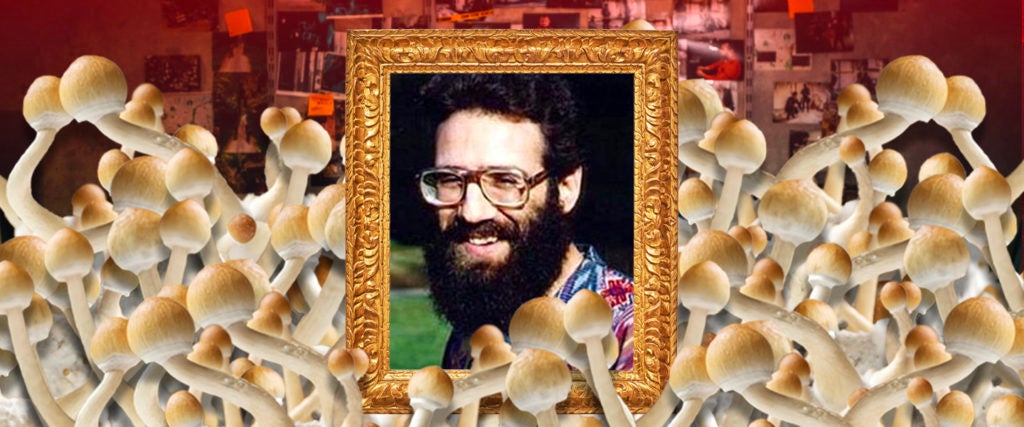It was just after 11 p.m. on January 31, 1981, when Dr. Steven Pollock, 33, was discovered by his girlfriend, who’d brought dinner for the two of them and certainly never expected to find her boyfriend with a bullet in his brain. He had been shot in the forehead, execution style.
When police removed Pollock’s body and emptied his home and lab of evidence, they carried out 1,758 jars of “magic mushrooms,” along with $225,000 in cash. Police found this odd; neither legitimate doctors nor scientific researchers usually keep nearly a quarter of a million dollars under their mattress.
In 1979, Pollock, along with two other San Antonio doctors, had formed Hidden Creek, a company focused on investigating the therapeutic properties of mushrooms and psilocybin (the active ingredient in shrooms). Pollock saw mycelium as nature’s best therapy and humanity’s salvation. But it was one particular type of magic mushroom, a very potent strain of the Psilocybe cubensis variety, that became the focus of Pollock’s professional life: the Penis Envy mushroom.
The Penis Envy mushroom took its name from its phallic appearance — the sort of well-endowed member that might bring about a little jealousy. Many believe the Penis Envy mushroom is the world’s most potent shroom. Really packing the goods, the envious cock-like fungus will fuck a person up the way only good dick can. It was so alluring and promising that, for Pollock, the Penis Envy mushroom became a fatal obsession.
These days, you can hop online and purchase an eighth of Penis Envy shrooms for $50 (Canadian), where you’ll find it described as “for people who are looking to have a full psychedelic experience.” For that, you can thank Terence McKenna, the ethnobotanist and psychonaut who first trekked into the Amazon and brought back spores of the Penis Envy mushroom, along with Pollock, who cultivated its spore lines and spread them among other shroom lovers and mycelium-heads.
Pollock brought his beloved Penis Envy to his Hidden Creek labs and went to work, eschewing pretty much all else. “We hardly ever went out. Our dates were spent shaking mushroom jars early into the morning, and the sex was often interrupted by technical raps about mushrooms,” his girlfriend Mitzi Moore said at the time of Pollock’s death. Pollock spent his days and nights feeding his spores with experimental concoctions like parakeet seed, barley, oats, rye grain, coffee grounds, pot seeds, soybeans, brown rice and even Purina cat food.
Pollock dreamed of establishing a legal, state-of-the-art mushroom cultivation center and research lab. He estimated the price tag would be $2,000,000, and the only way he knew how to raise that kind of money was to go fully illegal. He started out writing dubious prescriptions, then he eventually bought his own pharmacy to scale his side hustle. As Michael Forbes, his partner in Hidden Creek, recalled, “The office was a who’s who of San Antonio society. Drug use knows no socioeconomic boundaries, and so, on a given day you’d find scientists, government officials and the most strung-out junkies all waiting in line for their turn.”
Soon, Pollock was earning an estimated $10,000 a day writing prescriptions for Quaaludes and Percodan, growing illegal fields of pot and selling street drugs. Then there was his side business in San Antonio’s criminal underworld where he specialized in removing bullets from bodies.
But by January 1981, the walls, as they say, were closing in. The Texas Medical Board had begun proceedings to rescind Pollock’s medical license. The DEA was surveilling pot fields trying to tie their cultivation back to Pollock. And the local police had been tracking down prescription Quaaludes and found that a single pharmacy was responsible for filling 10,000 such prescriptions. Undercover San Antonio officers had gone to Pollock’s office and confirmed the obvious by getting him to write them prescriptions, too. In other words, it was just a matter of time.
As for January 31st specifically, Moore had prepared a pair of Cornish game hens for her and Pollock. She called him around 7 p.m. to tell him about it, and he was still in his home office, working. After he got off the phone with her, he took a call from his old colleague Paul Stamets — though the two were once close, personal rivalries had pushed them apart, and they hadn’t spoken for months. Stamets later recalled being annoyed by the constant interruptions to their call by people using Pollock’s other phone line. Then, Pollock told Stamets, “Some patients have pulled up for treatment. I’ll call you right back after they leave.”
Two hours later, after calling Pollock multiple times with no answer, Moore arrived at Pollock’s house with the food. At first, she assumed Pollock had lost track of time. But then she saw him in his office, lying on the floor. He’d had bad luck with experiments in the past, so she thought perhaps this just was another botched one that had knocked him out cold — until she spotted the blood stain on his sweater.
She ran from his home to one of his neighbors, who offered to call the police. Moore, however, asked them to avoid any rush to involve the cops. In the meantime, the neighbors went back with Moore to Pollock’s place and together they confirmed what she’d just seen –– blood and a bullet wound. The place, they realized, had been ransacked.
Though police originally had three suspects for the case, the district attorney at the time refused to prosecute. Mysteriously, the DEA destroyed all records on Pollock’s case, except for the ones around his cannabis fields. His murder, to this day, remains unsolved.
At his funeral, Pollock, the man who believed psilocybin would forever change humanity for the better, was presented in an open casket. A mushroom had been placed in each hand.

